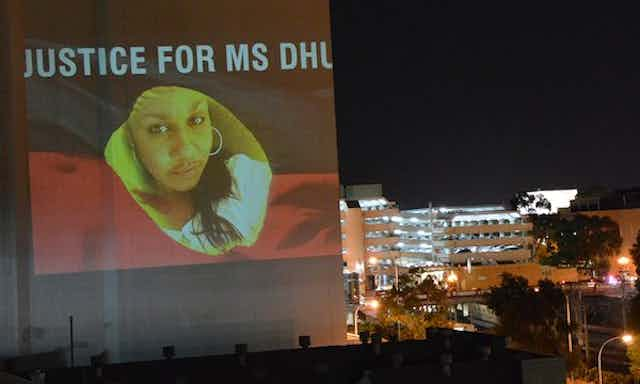Ms Dhu was a 22-year-old Yamatji woman who died in custody in the South Hedland Police Station in August 2014. Arrested for unpaid fines, she was already suffering from pneumonia and septicaemia caused by a broken rib, inflicted by her partner some months earlier. She became very ill overnight and died.
The 2015 coronial inquest into her death heard that police officers had believed that Ms Dhu was “faking”. At the inquest, footage was shown, reportedly revealing that police treated her roughly. Her family has asked that the CCTV footage of Ms Dhu’s final, agonising hours of life be released. So far, the coroner has refused this request.
For her family, the grief of seeing their girl die is outweighed by the need to demonstrate the injustice of how she died. An internal police investigation into Ms Dhu’s case found that 11 police officers failed to comply with police procedures, but none were fired or suspended.
It is time that authorities listened to the Aboriginal people most closely concerned, and agreed to release this footage.

Ms Dhu’s family’s demand to make her treatment in prison public echoes the argument of many visual theorists today: if others are forced to undergo suffering and pain, surely the privileged observer has a moral duty to witness, acknowledge and respond to what they see? But even more than this obligation to witness injustice, today photographic evidence has come to stand as proof.
Critic Susan Sontag famously argued that “without photographs, there is no war” – meaning that we need to see distant events to be convinced of their reality. There is no doubt that such images have tremendous power, serving as witness to atrocity, heartbreak and injustice. Following WWII in particular, the horrors of war were effectively conveyed via photography – with the revelation of the treatment of Jews in concentration camps such as Buchenwald in April 1945 shocking the world.
However, such images are not straightforward in their effects. In Australia, as many Aboriginal people have argued, such imagery may disempower their subjects, showing them as abject, distant or less-than-human. For example, one of the most effective critiques of Aboriginal treatment during the 1950s was a film, Their Darkest Hour (1957), made by West Australian MP William Grayden about Ngaanyatjarra people in the Warburton Ranges area, on the south-eastern fringe of the Gibson Desert.
This film included graphic, shocking imagery of ill and malnourished Aboriginal people. It successfully mobilised public concern across Australia and overseas well into the 1960s, contributing to a growing international concern about racial discrimination.
Specifically, it is credited with fuelling a wave of public support for the Aboriginal rights movement. This eventually led to the successful 1967 referendum to empower the Commonwealth in Aboriginal affairs. Yet, today, its subjects and their relatives resent the film’s shameful exposure of their lives and question the benefits that have ensued for them personally.

Aboriginal people now demand control over their own representation, using photography to assert a strong identity. They demand change on the basis of rights, rather than pity, with its overtones of patronage and condescension.
The Bicentennial was a turning point that forced the nation to acknowledge Indigenous dissent, as protests and marches literally demonstrated their demands. Visual symbols such as the 1972 Tent Embassy, a stroke of media genius, could not be denied.

Last week, Queensland Aboriginal man Noel Pearson tapped into this history of imagining Aboriginal suffering, in accusing the ABC of “racism”. Pearson suggested that the ABC needs:
blacks to remain alienated from mothers’ bosoms, incarcerated in legions, leading short lives of grief and tribulation – because if it were not so, against whom could they direct their soft bigotry of low expectations?
But many advances in the status of Aboriginal Australians have been prompted by revealing atrocious conditions and ill-treatment. Most recently, the ABC’s Four Corners revelation of a pattern of abuse, deprivation and punishment of vulnerable children within the Don Dale youth detention centre aroused intense public sentiment, prompting an inquiry into juvenile detention in the Northern Territory.
While we cannot – yet – see the CCTV footage of Ms Dhu’s treatment in custody, her family and supporters have tried to keep her presence alive in the city of Perth through clever use of light graffiti. Since 2015, they have been projecting night-time images of her face onto skyscrapers to assert her continuing memory and visibility. These storeys-high portraits of Ms Dhu and her family disrupt the urban landscape.
We believe that authorities must listen to her family and release the footage of Ms Dhu’s final hours. In revealing to all the injustice she suffered, her family hope that this graphic proof will arouse public opinion so that finally some good may come from her tragic death.
An Indigenous-curated exhibition, Rightfully Ours, Rightfully Yours, will open at the Perth Centre for Photography on Thursday, December 8. This exhibition will focus specifically on photography and Indigenous rights in Australia. It will open alongside a recreation of a historic photographic exhibition originally mounted by UNESCO in 1949 to explain the new Universal Declaration of Human Rights. These issues will also be the focus of the Visualising Human Rights Conference on December 5-6 at the Maritime Museum in Fremantle.

